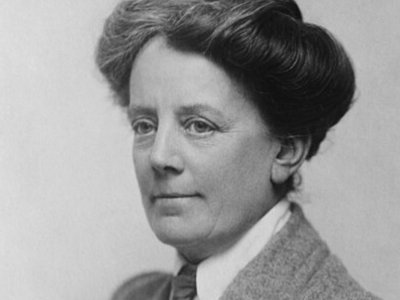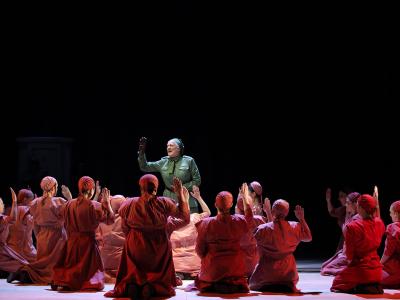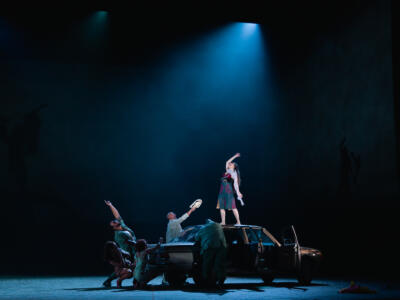
Dame Ethel Mary Smyth
(born Sidcup, Kent 22 April 1858; died Woking, Surrey 8 May 1944)
Dame Ethel Mary Smyth was a ground-breaking English composer and suffragist whose remarkable career defied the societal norms of her time. Born into a privileged background, Smyth eschewed societal expectations to pursue her passion for music and women’s suffrage. In this guide, you can find out more about her music, compositions and her life…
The life of Ethel Smyth: A summary
Discover more about Ethel Smyth’s life and career, including her education and influences, background, career and key accomplishments. It will also cover her most notable works, along with her music in action.
Early Life and Education
Ethel Smyth was born on April 23, 1858, in Sidcup, Kent, England, into a prosperous military family. Her father, General J. H. P. Smyth, recognised her early musical talent and encouraged her pursuits, despite prevailing gender norms. Growing up in an environment of relative privilege, Smyth received piano lessons and developed a passion for music.
In her younger years, she defied societal expectations for a woman of her class, exhibiting a strong-willed character and a determination to pursue her artistic ambitions. Her family’s support allowed her to break away from conventional roles, paving the way for her journey into the world of music.
In 1877, she enrolled at the Leipzig Conservatory, studying under renowned composer Carl Reinecke and subsequently with Heinrich von Herzogenberg. These formative years in Germany exposed her to the flourishing musical scene and influenced her compositional style. Smyth’s education was foundational, shaping her into a skilled composer.
Returning to England, Smyth’s career gained momentum with performances of her chamber and orchestral works. Notable achievements include her breakthrough work, Mass in D and the success of her first opera, Fantasio. Despite facing gender biases, Smyth persisted, earning acclaim for her compositions and carving a path for future female composers.
Smyth’s youth was marked by a defiance of societal expectations, evident in her pursuit of music against gender norms. Her upbringing in a supportive environment, coupled with a determined spirit, laid the groundwork for an extraordinary career that transcended both musical and societal boundaries.
Career Highlights
Ethel Smyth’s career was characterised by a prolific output, marked by innovative compositions and a passionate commitment to both music and societal change.
Smyth gained recognition for her operatic works, with The Wreckers (1904) being one of her most acclaimed operas. Set in a Cornish village, the opera explores themes of morality and social issues. Smyth’s dynamic use of orchestration and dramatic storytelling contributed to its success. Perhaps Smyth’s most famous composition is The March of the Women (1910), which became a powerful anthem for the suffragette movement. Inspired by her experiences as a suffragist, the anthem’s rousing melody and lyrics captured the spirit of the women’s rights movement. Smyth’s contributions to orchestral and chamber music are noteworthy. Her Mass in D (1891) and Double Concerto for Violin and Horn (1927) showcase her mastery of composition and orchestration. The Mass, in particular, received critical acclaim for its grandeur and emotional depth.
Smyth faced challenges as a woman in the male-dominated field of classical music. Her activism for women’s suffrage led to a two month prison sentence in 1912, an experience she captured in her book ‘Streaks of Life’ (1921), adding another layer to her public persona. Smyth associated with prominent figures of her time, including fellow composers like Clara Schumann and Johannes Brahms. Her friendship with suffragist Emmeline Pankhurst also influenced her political involvement.
While Smyth’s career faced challenges due to gender bias, her resilience, musical talent, and dedication to social causes left an indelible mark on the history of classical music and women’s rights.
Later Life
In her later years, Ethel Smyth continued to compose and contribute to the world of classical music. Smyth’s later works reflected her continued creativity and exploration of diverse musical forms. The Prison (1930), an oratorio, stands out as one of her final major compositions. This work explores philosophical and existential themes, showcasing Smyth’s ability to grapple with complex subject matter.
At the age of 71, Ethel Smyth met and fell in love with the writer Virginia Woolf, who was 25 years her junior. In her diaries, she wrote “I don’t think I have ever cared for anyone more profoundly”; in contrast, Virginia wrote in her own diary “an old woman has fallen in love with me. It’s like being caught by a giant crab.” However, despite their differences, the two women embarked on a powerful friendship which endured until Woolf’s death in 1941.
Despite facing hearing loss as she aged, Smyth persisted in her musical pursuits. Her determination to overcome physical challenges and continue composing demonstrated her unwavering commitment to her craft. In addition to her musical contributions, Smyth penned her autobiography, ‘Streaks of Life’, published in 1921. The book provides insights into her personal and professional life, offering a first-hand account of her experiences as a composer and suffragist.
She spent her later years in Woking, Surrey and as her health declined, she still remained active in the cultural and political spheres. Despite physical limitations, she continued to engage with the world around her. Ethel passed away on May 8, 1944, at the age of 86. Her death marked the end of a pioneering career that spanned decades and left an indelible impact on the classical music landscape.
Smyth’s legacy is multifaceted. As a composer, she played a crucial role in breaking gender barriers in classical music. Her works, characterised by a distinctive voice and innovative approaches, continue to be studied and performed. Smyth’s contributions to the suffragette movement further solidify her legacy as a pioneer for women’s rights. In recognition of her achievements, Smyth was made a Dame Commander of the Order of the British Empire (DBE) in 1922, highlighting her significant contributions to the arts.
Ethel Smyth’s legacy extends beyond her music, encompassing her role as a symbol of resilience, determination, and advocacy for women’s rights. Her impact on the classical music world and her pioneering spirit continue to inspire musicians and enthusiasts alike, underscoring the importance of her contributions to both art and social progress.
Smyth’s musical style and influence
Ethel Smyth’s musical style is characterised by its boldness, emotional depth, and innovative approaches, placing her as a significant figure in late 19th and early 20th-century British music. Several key aspects define Smyth’s musical style:
- Late-Romantic Aesthetic: Smyth’s compositions are firmly rooted in the late-Romantic tradition. Her music often features lush harmonies, expressive melodies, and a penchant for grandiosity reminiscent of the Romantic era. The influence of Brahms and Wagner is discernible, as Smyth absorbed elements of their styles during her studies in Leipzig.
- Chamber Music and Orchestration: Smyth demonstrated a mastery of orchestration, evident in works such as her Mass in D and the Double Concerto for Violin and Horn. Her chamber music, including string quartets and sonatas, showcases her ability to create intricate textures and explore a wide range of emotions within smaller ensembles.
- Operatic Innovation: Smyth made notable contributions to the operatic repertoire, particularly with her opera The Wreckers. Her operatic style is characterised by dramatic storytelling, strong character development, and a keen sense of orchestral colour. She defied conventions, experimenting with new forms and harmonic language to convey the emotional intensity of her narratives.
- Suffrage Anthem: The March of the Women exemplifies Smyth’s ability to compose powerful and memorable vocal music. The anthem became an iconic piece associated with the suffragette movement, showcasing her capacity to infuse political themes into her compositions.
- Programmatic Elements: Many of Smyth’s works incorporate programmatic elements, where she sought to convey narratives or ideas through music. This is evident in her orchestral tone poem On the Cliffs of Cornwall and her operatic storytelling in works like The Boatswain’s Mate.
- Nationalism: While Smyth’s music is firmly rooted in the Germanic tradition due to her studies in Leipzig, she also demonstrated a sense of British nationalism in her compositions. This is evident in her use of folk melodies and themes inspired by her homeland, infusing her music with a distinct English flavour.
- Legacy and Influence: Ethel Smyth’s legacy extends beyond her compositions. As one of the first female composers to achieve prominence, she paved the way for future generations of women in classical music. Her boldness and determination to challenge gender norms left a lasting impact, inspiring subsequent generations of composers and performers.
While Smyth’s music may not have directly spawned a distinct school or style, her pioneering spirit and dedication to pushing artistic and societal boundaries have left an enduring mark on the world of classical music. Her influence is felt not only through the emotional resonance of her compositions but also through her role as a leader for gender equality in the arts.
Smyth’s most famous songs
Ethel Smyth is more widely known for her larger works, such as operas, choral compositions, and orchestral pieces, rather than individual songs. However, she did compose vocal works and songs that have gained recognition. Here’s a selection of some of her notable songs:
- The March of the Women (1910): This anthem became a symbol of the suffragette movement and is perhaps Smyth’s most famous composition.
- Laggard Dawn (1911): A poignant song for voice and piano, reflecting Smyth’s commitment to the suffrage cause.
- Possession (1930): A later composition showcasing Smyth’s continued exploration of complex emotions, written for voice and piano.
- Odelette (1889): A song for voice and piano, showcasing Smyth’s early compositional style.
- Four Songs for Mezzo-Soprano, Horn, and Piano (1927): A set of songs highlighting Smyth’s chamber music abilities.
- Madeleine (1903): A song for voice and piano, demonstrating Smyth’s lyricism.
- The Clown (1888): An early vocal work that reveals Smyth’s evolving style.
- Parting (1908): A song for voice and piano, showcasing Smyth’s expressive capabilities.
- The Boatswain’s Mate (1913): While this is an opera, it includes several arias and vocal pieces that contributed to Smyth’s reputation.
- On the Cliffs of Cornwall (1916): While more of a tone poem, this orchestral work includes vocal elements and reflects Smyth’s connection to her homeland.
While Smyth’s larger-scale compositions, including operas and orchestral works, are more widely celebrated, these songs offer glimpses into her diverse and expressive musical language
Smyths most famous operas
Find out more about music by Ethel Smyth that has been performed by ENO, as well as operas by other famous composers on our Discover Opera page
FAQs
How did Ethel Smyth die?
Ethel Smyth died on May 8, 1944, at the age of 86. She passed away at her home in Woking, Surrey, England. Smyth had faced declining health in her later years, and the cause of her death was heart failure.
How to pronounce Ethel Smyth?
The name “Ethel Smyth” is pronounced as follows:
- Ethel: EH-thuhl
- Smyth: SMI-th (the “th” is pronounced as in “this” or “think”)
So, it is pronounced “EH-thuhl SMI-th.”
What is Dame Ethel Smyth famous for?
Dame Ethel Smyth is famous for her contributions to classical music as a composer and for her activism in the women’s suffrage movement.



